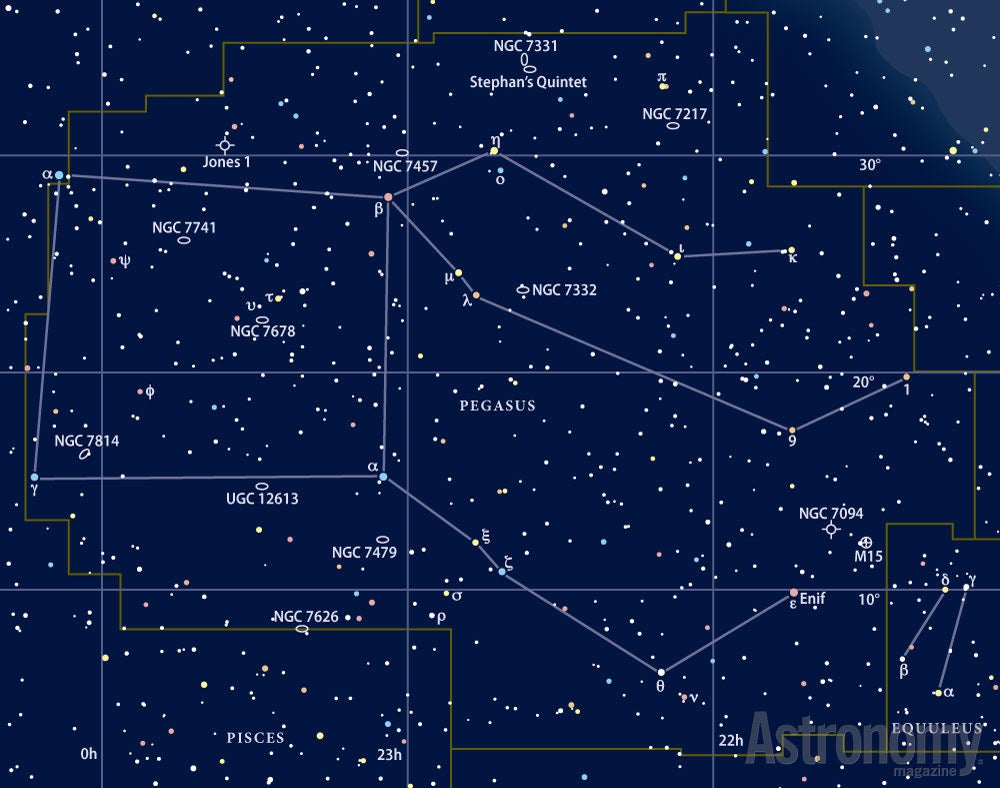Targets for October 1-8, 2015
Naked eye: The Great Square of Pegasus
Small telescope: Globular cluster M15
Large telescope: Stephan’s Quintet
In the fall, our thoughts — OK, my thoughts — turn to the baseball playoffs that lead up to the World Series. To see the celestial baseball game, step outside around 9 p.m., and locate the Great Square of Pegasus.
The name’s a bit misleading because the Square’s brightest star belongs to Andromeda. Nevertheless, let’s imagine Beta (β) Pegasi, the star at the Square’s northwestern edge, as home plate. Head eastward to Alpha (α) Andromedae. That’s first base. Turn south and run to Gamma (γ) Pegasi. That’s second base. Another left turn leads you to Alpha Pegasi — third base.
Look within the Square for a pitcher’s mound — pick whichever faint star you want, perhaps magnitude 4.4 Upsilon (υ) Pegasi.
Behind (that’s west of) home plate, are the stars Eta (η) and Omicron (ο) Pegasi that represent the batter and the umpire. The batter’s complaining the game’s unfair, and he does have a point. Look at all the outfielders!
One object you can find by using the stellar baseball diamond is the Andromeda Galaxy (M31). Start at home plate, head to first base, then continue down the right field line two medium bright stars; turn right, and head two more stars into the grandstand. Look around (binoculars will definitely help), and you’ll see a soft glow marking the Andromeda Galaxy.
A sphere of fireflies
For Northern Hemisphere observers, M15 ranks as autumn’s showpiece globular cluster. From a dark site, sharp-eyed observers can spot magnitude 6.3 M15 with their naked eyes. Don’t be confused by the magnitude 6.1 star only 17′ to the east. Confirm your sighting through your telescope.
And speaking of telescopes, a 4-inch scope will resolve dozens of stars around M15’s strikingly bright core. Look for the chains of stars that wind out from its central region. Through a small telescope, these star patterns cause some observers to describe M15 as slightly oval.
Finding M15 is pretty easy. Use Theta (θ) and Epsilon (ε) Pegasi as pointers. Just draw a line from Theta through Epsilon, and continue another 4°.
A tough cluster of galaxies
One of the mantras of amateur astronomy is “aperture rules.” This means you’ll see more detail as you observe through ever-larger telescopes. Few celestial objects demonstrate this better than Stephan’s Quintet.
French astronomer Edouard Stephan discovered this group in 1877. The five galaxies now carry the designations NGC 7317, NGC 7318A, NGC 7318B, NGC 7319, and NGC 7320.
Four of these galaxies — the exception is NGC 7320 — form a compact galaxy group, the first ever discovered. NGC 7320 belongs to the Pegasus Spur, a group of about three dozen galaxies, the brightest of which is magnitude 9.5 NGC 7331.
Although you can “see” Stephan’s Quintet through a 6-inch scope, 50x will show you only a clumpy glow 3′ across. A 12-inch telescope, on the other hand, lets you identify the individual members.
At the Quintet’s southwestern edge is NGC 7317, which lies next to a 13th-magnitude foreground star. The colliding pair NGC 7318A and NGC 7318B lies 2′ to the east. You’ll need high magnification — above 200x — to “unmerge” them.
The brightest and largest member, NGC 7320, lies to the southeast and contains a 13th-magnitude foreground star in its halo. This galaxy shines at magnitude 12.5. NGC 7319, which sits at the group’s northeastern edge, is the real test for visual observers and is the faintest galaxy in Stephan’s Quintet. It glows softly at magnitude 15.3.
Expand your observing at Astronomy.com
StarDome
Check out Astronomy.com’s interactive StarDome to see an accurate map of your sky. This tool will help you locate this week’s targets.
The Sky this Week
Get a daily digest of celestial events coming soon to a sky near you.
Observing Basics
Find more guidance from Senior Editor Michael E. Bakich with his Observing Basics video series.











